
Longread
‘Water and soil guiding’ calls for a broad perspective
There is currently much ado in the Netherlands about the ‘water and soil guiding’ approach. WUR has been working according to this principle for a while already, But what exactly is it, and what should you do and avoid to successfully implement ‘water and soil guiding’? In this publication, we share our insights and experiences
Bertram de Rooij, Hessel Woolderink, Bas Breman, Arjan Budding, Myrjam de Graaf and Sabine van Rooij – spring 2023
This article in 1 minute
- ‘Water and soil guiding’ means that the soil and water systems have a critical role in how the Netherlands is designed, thus making our nation more climate resilient and relieving pressure on biodiversity. This results in a healthy and robust economy, society and living environment.
- The soil and water systems are made up of different mutually influential parts. If you turn one dial, the rest of the system moves also. Hence, we must consider ‘water and soil guiding’ as a coherent whole rather than focus on the system’s individual parts.
- To successfully implement ‘water and soil guiding’, we need insight into the soil-water system, an integrated future perspective and a clear assessment framework for our spatial decisions. Moreover, we must consider what is socially and administratively desirable and feasible.
In 2022, the cabinet decided on ‘water and soil guiding’ as a guiding principle for spatial planning in the Netherlands. At first glance, the principle may seem straightforward. Nevertheless, including it in concrete solutions for issues in society appears challenging.
One thing is certain: there is significant pressure on the Dutch soil-water system. The water quality is insufficient, groundwater levels are declining, and the soil is often of poor quality. This is the result of how we use the soil and water and the choices we make in how to use the land. If we aim to continue living safe and healthy lives in the Netherlands, we must act now.
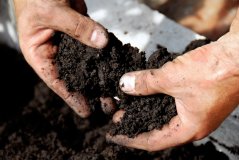
We must first understand how our soil-water system works to base spatial planning on the ‘water and soil guiding’ principle. The principle of ‘water and soil guiding’ is currently interpreted in many different ways, frequently resulting in only one aspect of the soil-water system being taken into account. Hence, one may rapidly lose sight of the interdependency and mutual influence between the system’s different parts.
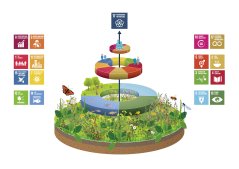
When we refer to ‘soil’, we may be referring to soil type or aspects such as geomorphology (how the landscape is formed), soil quality or soil fertility.
When we discuss water, we may mean the surface water system, the groundwater system or water security and safety. Thus, the terms ‘soil’ and ‘water’ represent many different subsystems that are mutually coherent. To add to this, the subsystems are partially determined by how we use the land, on which they, in turn, are a determining factor.
How we view 'water and soil guiding'
In 2019, Wageningen University & Research scientists published a future perspective for the Netherlands entitled: A more natural future for the Netherlands in 2120. This perspective is based on the ‘water and soil guiding’ approach as one of its fundamental principles. For example, we will no longer build new cities in areas prone to flooding. And: we opt for high-value circular agriculture.
This 2120 perspective illustrates what we think the ‘water and soil guiding’ principle is all about. To apply the principle correctly, we must learn to view the natural system as a whole. The soil in which plants grow roots and in which organisms live, the subsoil, the water system, ecology and the way in which we use the land are inextricably intertwined.
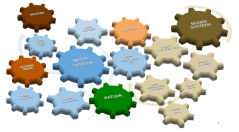
‘Water and soil guiding’ provides a solid foundation for the various challenges in spatial planning that the Netherlands faces and should thus be a guideline. Not everything works everywhere. And more importantly, many things work better when applied in the right place.
To this end, we must have a joint agreement on what type of land use or measures work, where, and why. Moreover, we must consider how ‘water and soil guiding’ fits in with what is socially and administratively appropriate. Decision-making is never purely based on technical facts but includes the values and ideas of those involved in the process. That is why different regions may take different measures.
An interesting fact is that, historically, water and soil have significantly influenced our culture. It is not without reason that many regions still discern between ‘those from the sands’ and ‘those from the peat’.
The soil-water system in the Netherlands is an interplay between the various parts. For example, the landscape’s topography, subsoil, soil, water system, ecology and land use. If you have a proper view of the relationships between these parts, you can predict how changes in one subsystem will affect the other systems.
Finally, illuminating why we should adopt a different approach in the Netherlands is helpful. This will help inform stakeholders about the added value and the consequences that ‘water and soil guiding’ may have for them. We can then work on a collective perspective for the future and the implementation thereof.
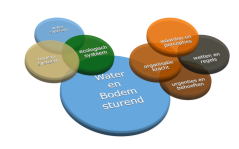
What does 'water and soil guiding' yield?
Honing in on that last question: a healthy soil-water system ensures a resilient and climate-adaptive environment for humans, plants and animals. The natural system incurs less damage and becomes more robust, thus becoming preserved for future generations – in good, or even in better, condition than it now is. How important that is, was underscored by the Minister of Infrastructure and Water in a letter to the House of Representatives (in November 2022) on the role of water and soil in spatial planning.1
A healthy soil-water system has many advantages, of which we will list four below as examples:
1. The Netherlands is better able to resist heat, drought and flooding
Climate change causes an increase in extreme weather: heavy precipitation in a short time, for example, or heatwaves and lengthy dry spells. A robust soil-water system functions as a buffer to cushion the effects of weather extremes such as heat, drought and excess water. Healthy soil retains more water, which not only helps prevent flooding but also means that the ground becomes less desiccated in times of drought. It also prevents damages and costs related to re-modelling areas that have become desiccated or flooded.
2. The balance between agriculture and the soil-water system is restored
There are many different forms of agriculture in the Netherlands, ranging from soil-centred agriculture -where the soil is a key determinant in how much can be produced- to building-centred agriculture, where the soil is a lesser factor in determining the production volume. Examples of the latter include intensive livestock farming and closed cultivation systems.
In the past century, the soil-water system has been increasingly altered by human activity to make agriculture possible in areas that were otherwise ill-suited for such activity. The flip side is becoming increasingly apparent. It is not just the soil-water system that is under pressure, but agriculture itself.
The soil-water system enables us to determine what type of agriculture would be best in a particular area. The diversity within this system is the foundation for many different types of farming: regenerative, nature-positive, nature-inclusive, high-tech, building-centred and closed systems. Even the latter is always related to soil and water, through, for example, soil coverage, water storage and the stability of the substrate.
In short, a ‘water and soil guiding perspective’ calls for agriculture in harmony with the soil-water system, less dependent on artificial fertilisers and more resilient against extremes. Thus shifting agriculture from being part of the problem to being part of the solution.
3. Biodiversity in nature reserves and om the landscapes that lie in between is increased
There are a number of Natura-2000 areas in the Netherlands. These areas were designated by the government and are protected under European guidelines. Dutch nature policies focus on maintaining the status quo with regard to the Natura-2000 areas. However, there is more nature in the Netherlands, such as the green in between the Natura-200 areas that contribute to a functioning soil-water system and increasing biodiversity. This adds value to the areas themselves and to the connected areas.
Wide creek valleys, for example, help retain water and supplement groundwater. As a result, water remains available in the creeks even during dry spells, preventing the deaths of plants and animals that depend on the water in the creek. Moreover, it increases the availability of water for agriculture and drinking purposes. Further downstream, the risk of flooding is mitigated. Broad creek valleys make the surrounding nature areas more resilient. Different ecosystems are supported by designing a ‘nature-positive’ landscape, which means multiple solutions are supported simultaneously.
4. Mutual reinforcement between urban and rural areas
A green, healthy urban living environment and a strong rural area go hand in hand. Policies currently discern between urban and rural areas, which significantly impacts the soil-water system, ecology and biodiversity. Solutions are often viewed from a singular, urban or rural perspective, while including both areas in our considerations will yield structural solutions.
A waterway flowing from the country to the city is frequently restricted in the city by stone banks. Should we allow more room for natural banks and vegetation, a softer and more natural transition from rural to urban would be created. The resulting ecological link benefits biodiversity.
Additionally, city-dwellers will more easily find their way to the surrounding areas. And, should excessive precipitation affect the city, the solution may well lie in how the upstream area’s water system is designed.
The soil and water are often invisible in urban areas. I call for a symbiotic city where humans make room for the ecosystem, the soil, water and natural organisms. That starts with a proper ‘collaboration’ between the soil and water.
Water and soil guiding in practice
It is clear that ‘water and soil guiding’ had added value. But how can we apply this principle? Spatial issues are currently still being addressed at sectoral levels. As a result, the solution for one challenge may easily make another challenge even more difficult. This sectoral approach prevents the embedding of ‘water and soil guiding’.
Consider, for example, the housing shortage. There is no doubt that many new homes are needed in the Netherlands. Still, we continue to construct housing in areas that are ill-suited for such activities now that the sea levels are rising and rivers have so much more water to process. These construction projects make it more difficult to adapt to climate change. Worse: it is already causing damage and frustration. The threat of flooding along the Linge in 2023, for example, begs the question of what precisely the problem was: the elevated water levels, or houses constructed at that exact location.
A similar situation applies to agriculture. In recent years, drought has caused substantial damage to crops. To solve this issue, you may decide to work on the water system. But you may also choose to consider what crops we are growing (do they need a lot of water?) and the way we use the land.
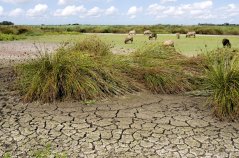
Four concepts
What do we want? Water and soil guiding calls for four crucial concepts that must always be included. We must prevent the passing on of problems and challenges to 1) other regions, 2) other sectors, 3) other soil-water system functions, and 4) the next generations.
The letter to the chamber states that the founding principle is ‘water and soil guiding’ (comply) unless there is a reason not to (explain). We must rely on the latter option in as few cases as possible. Comply should be the standard.
In other words: we must solve issues with water and soil at a fundamental level, and fundamentally, or we will just be postponing the issue. This means we must discuss the future. And we must embrace, understand and utilise the cohesion of soil-water systems between regions. In doing so, we must include all of the subsystems through an integrated assessment of how land in a particular region is used.
Our biggest challenge is these last two concepts of not passing issues on to other functions and future generations. They call for a continuous dialogue between stakeholders from various regions and sectors: from experts on the soil to ecology, with a focus on the economy and consideration for future generations.
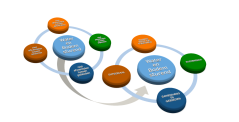
In conclusion
Insight into the soil-water system alone is insufficient since applying this knowledge in practical situations is human work. And as is the case in many decision-making processes, many different concerns and considerations are involved. The issues may even be extremely politically sensitive. In order for water and soil guiding to be successful, we must not lose sight of the social and administrative aspects. What decisions are supported, what are their effects and for whom, and how can we include all stakeholders in the process? In considering these questions, we must take into account not only the current concerns and considerations but also those of future generations, as the spatial decisions we make today will have effects for many generations to come.
To this end, a regional approach is needed based on a collective understanding of the soil-water system, the DNA of the landscape and a solid basis of knowledge. From there, the practical details will emerge.
Diligently tailored solutions are needed to design a sustainable landscape in the Netherlands. Only thus will we discover the best options for local, regional and national spatial policies. Water and soil guiding: a foundation for the future.